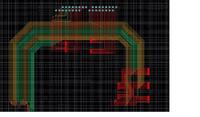s3034585
Full Member level 4
multi drop bus termination
Hi Guys
i have a dought about routing multi drop bi-directional bus. can some pls share there view on this.
my current project pcb is 6 layers and contains 2 processors, fpga, 2 cpld's. each channel has a processor and cpld. i am trying to route add and data bus between processor- cpld -fpga-back plane connector. is it a good idea to tap the trace to vias form all the four side(in diff layers). like a plus sign with a device at each end of the trace. the placement of the components is the reason for this kind of routing.
can some pls share there view on it
thanks in advance
tama
 ][/img]
][/img]
Hi Guys
i have a dought about routing multi drop bi-directional bus. can some pls share there view on this.
my current project pcb is 6 layers and contains 2 processors, fpga, 2 cpld's. each channel has a processor and cpld. i am trying to route add and data bus between processor- cpld -fpga-back plane connector. is it a good idea to tap the trace to vias form all the four side(in diff layers). like a plus sign with a device at each end of the trace. the placement of the components is the reason for this kind of routing.
can some pls share there view on it
thanks in advance
tama
 ][/img]
][/img]